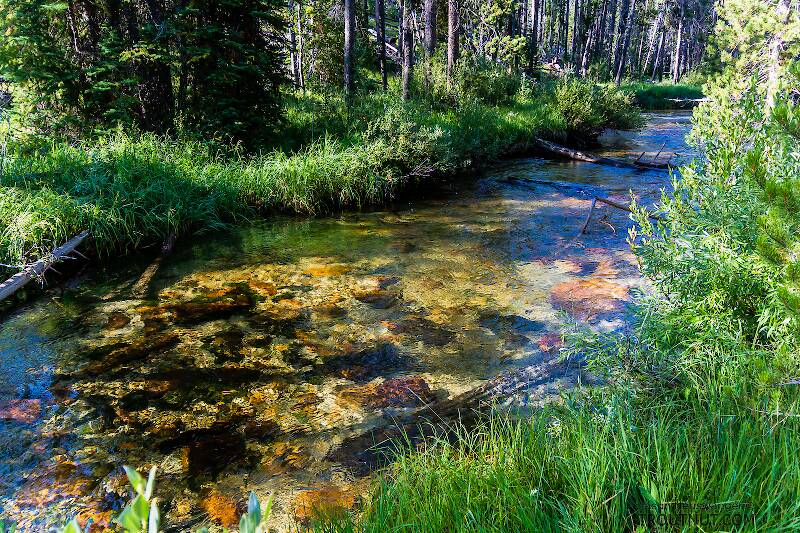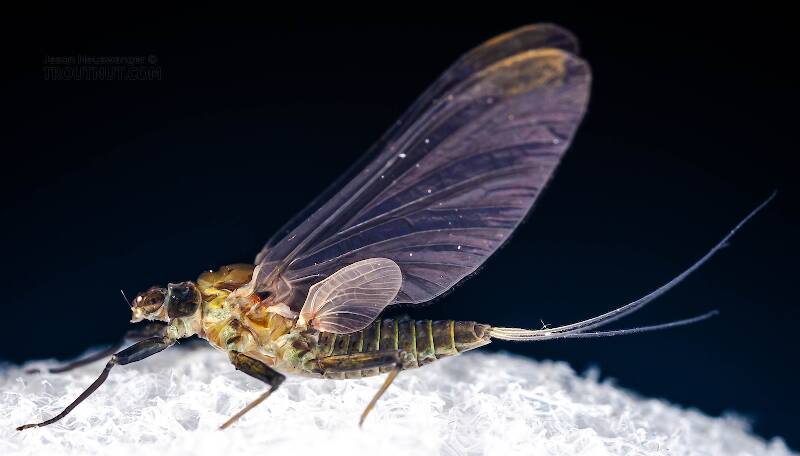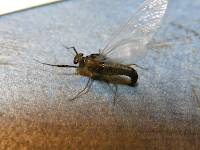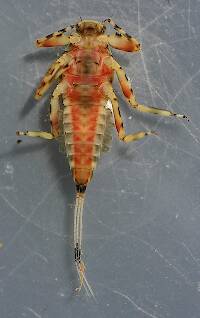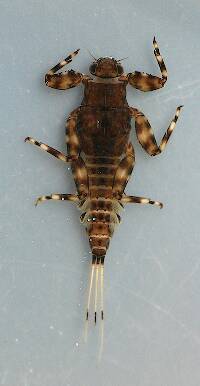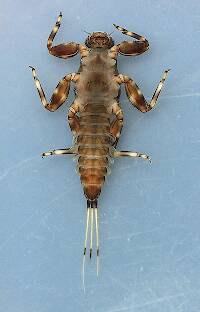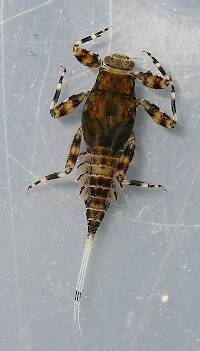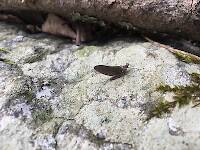
Hex Mayflies
Hexagenia limbata
The famous nocturnal Hex hatch of the Midwest (and a few other lucky locations) stirs to the surface mythically large brown trout that only touch streamers for the rest of the year.
Featured on the forum

Nymphs of this species were fairly common in late-winter kick net samples from the upper Yakima River. Although I could not find a key to species of Zapada nymphs, a revision of the Nemouridae family by Baumann (1975) includes the following helpful sentence: "2 cervical gills on each side of midline, 1 arising inside and 1 outside of lateral cervical sclerites, usually single and elongate, sometimes constricted but with 3 or 4 branches arising beyond gill base in Zapada cinctipes." This specimen clearly has the branches and is within the range of that species.

Troutnut is a project started in 2003 by salmonid ecologist Jason "Troutnut" Neuswanger to help anglers and
fly tyers unabashedly embrace the entomological side of the sport. Learn more about Troutnut or
support the project for an enhanced experience here.
This topic is about the Mayfly Species Drunella tuberculata
Example specimen
Konchu on Sep 20, 2009September 20th, 2009, 8:04 am EDT
Just got back from a trip to the North Carolina side of the Smokies. Drunella tuberculata (probably the conestee form) is getting ready to hatch there. Most of the other bugs of decent size that I saw were relatively young.
Pastorray on Nov 26, 2009November 26th, 2009, 3:19 am EST
Yes, I'm new to this site and was wondering if you have done any fly fishing in the Smokies during the winter...say Jan., or Feb.? I've done some in April on the NC side and did rather well, but like to try it in colder weather... Thanks , Pastor Ray
Pastor Ray
Teddyp on Nov 26, 2009November 26th, 2009, 12:27 pm EST
I live on the NC side and fish the smokies throughout the year. The winter fishing is pretty good, but obviously slow as the temperatures drop, but don't get as cold as up north. Nymphing through the winter when the sun is out can be good!
Ted
Taxon on Nov 26, 2009November 26th, 2009, 4:02 pm EST
Hi Luke. Interesting. Must have (somehow) missed your post when you made it on September 20. Haven't previously seen any emergence dates for Drunella tuberculata, but they must one of the latest-emerging Drunella species.
Konchu on Nov 27, 2009November 27th, 2009, 1:25 pm EST
Taxon, that Drunella is the old D. conestee, at least I'm pretty sure.
Pastorray and Teddyp, I've seen various BWOs emerging in good numbers up into December, if the day is warm enough.
Pastorray and Teddyp, I've seen various BWOs emerging in good numbers up into December, if the day is warm enough.
CrUNChstONE on Jan 3, 2010January 3rd, 2010, 6:49 am EST
Your best bet would be Abrams Creek because it originates underground and the water stays warmer during the winter than anywhere else in the park. P.S. Try BWO's, midges, and little black stone fly nymphs.
Stay classy.
Konchu on Jan 4, 2010January 4th, 2010, 12:22 pm EST
Abrams Cr and its tribs is where I collected the winged BWOs & other baetids!
Quick Reply
Related Discussions
Topic
Replies
Last Reply
1
Apr 18, 2007
by Troutnut
by Troutnut
15
Jul 24, 2007
by GONZO
by GONZO
8
Sep 21, 2009
by GONZO
by GONZO
9
Jul 22, 2014
by Crepuscular
by Crepuscular

